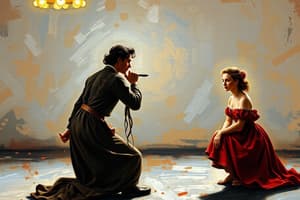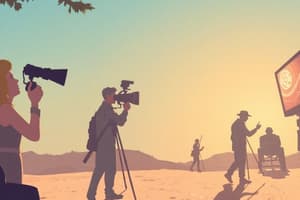Podcast
Questions and Answers
Why did Romans and Greeks require safeguards for actors when portraying emotions?
Why did Romans and Greeks require safeguards for actors when portraying emotions?
- To limit improvisational acting and keep performance consistent
- To prevent actors from becoming ill due to the intensity of emotions (correct)
- To adhere to traditional performance customs
- To ensure the actors accurately conveyed the intended message
What distinguishes commedia dell'arte from other forms of theater?
What distinguishes commedia dell'arte from other forms of theater?
- Strict adherence to written scripts and formal acting styles
- Reliance on elaborate stage machinery and special effects
- Use of masked "types" and improvised performances based on sketches (correct)
- Emphasis on realistic sets and costumes
What central idea did Francois Delsarte advocate regarding gestures in acting?
What central idea did Francois Delsarte advocate regarding gestures in acting?
- External gesture is only the reverberation of internal gesture and motive (correct)
- External gesture should be generic to make emotions easier to understand
- External gesture is the only way to release emotion
- Actors should aim to only use external gestures to ensure the emotions aren't too overwrought
What techniques that Brecht implemented had the intention to disrupt the audience's tendency to fall into a dream?
What techniques that Brecht implemented had the intention to disrupt the audience's tendency to fall into a dream?
What belief was Stanislavski passionate about?
What belief was Stanislavski passionate about?
Match the Stanislavski system-included ideas with the description:
Match the Stanislavski system-included ideas with the description:
According to Stanislavski, an actor uses an ______ to inform a moment in their character's reality.
According to Stanislavski, an actor uses an ______ to inform a moment in their character's reality.
How can well known acting teachers can you trace back to Stanislavski and his theories?
How can well known acting teachers can you trace back to Stanislavski and his theories?
Lee Strasberg's teachings are universally praised in America without controversy.
Lee Strasberg's teachings are universally praised in America without controversy.
What is 'Affective memory' according to Stanislavski's?
What is 'Affective memory' according to Stanislavski's?
What led to Stella Adler breaking off from the Group Theatre?
What led to Stella Adler breaking off from the Group Theatre?
Which elements are in Meisner's technique to properly carry out the action on stage?
Which elements are in Meisner's technique to properly carry out the action on stage?
What quality did Viola Spolin see as being often lost in American acting?
What quality did Viola Spolin see as being often lost in American acting?
In stage terminology, what does 'above' mean in relation to the audience?
In stage terminology, what does 'above' mean in relation to the audience?
Which definition accurately describes the term 'apron' in stage terminology?
Which definition accurately describes the term 'apron' in stage terminology?
A ______ is a long pipe or strip of wood on which scenery or drops are hung.
A ______ is a long pipe or strip of wood on which scenery or drops are hung.
The 'fourth wall' is a physical partition on stage used to create distinct acting spaces.
The 'fourth wall' is a physical partition on stage used to create distinct acting spaces.
Which term refers to flats or curtains at the extreme right and left of the stage, used to mask wings?
Which term refers to flats or curtains at the extreme right and left of the stage, used to mask wings?
What does it mean to 'cheat' in the context of stage performance?
What does it mean to 'cheat' in the context of stage performance?
The 'cue-to-cue' rehearsal involves running the entire play from beginning to end.
The 'cue-to-cue' rehearsal involves running the entire play from beginning to end.
In stage directions what does 'Give stage' mean?
In stage directions what does 'Give stage' mean?
The person who writes the plays are often called ______.
The person who writes the plays are often called ______.
What role is responsible for maintaining the safety and comfort of the audience members after the show has been created?
What role is responsible for maintaining the safety and comfort of the audience members after the show has been created?
In the imaginary object assignment, what should be the main focus of your actions?
In the imaginary object assignment, what should be the main focus of your actions?
In the imaginary object assignment, it's encouraged to introduce imaginary people or animals to enhance the scene.
In the imaginary object assignment, it's encouraged to introduce imaginary people or animals to enhance the scene.
What constraint best describes the A/B scenes assignment?
What constraint best describes the A/B scenes assignment?
What key element should the actor focus on when in the Personal Monologue Assignment?
What key element should the actor focus on when in the Personal Monologue Assignment?
Improvisation is allowed in the Personal Monologue Assignment.
Improvisation is allowed in the Personal Monologue Assignment.
What will help people remember their lines almost automatically?
What will help people remember their lines almost automatically?
Why should you not 'go up' on your lines even in class?
Why should you not 'go up' on your lines even in class?
Define each term to its proper answer:
Define each term to its proper answer:
What is considered to be the key of professionalism?
What is considered to be the key of professionalism?
What's not the creative process as defined in the context?
What's not the creative process as defined in the context?
Flashcards
Who was Thespis?
Who was Thespis?
First Western actor, separated from the Greek Chorus, started acting.
Roman & Greek Emotion belief
Roman & Greek Emotion belief
Powerful emotions cause illness, actors needed safeguards.
Classical Chinese Performance
Classical Chinese Performance
Highly stylized with movement, dance, chant and music.
Classical Africa Theatre
Classical Africa Theatre
Signup and view all the flashcards
Commedia dell'Arte
Commedia dell'Arte
Signup and view all the flashcards
Acting is doing
Acting is doing
Signup and view all the flashcards
Given circumstances
Given circumstances
Signup and view all the flashcards
Objective
Objective
Signup and view all the flashcards
Above/Below
Above/Below
Signup and view all the flashcards
Apron
Apron
Signup and view all the flashcards
Arch
Arch
Signup and view all the flashcards
Arena
Arena
Signup and view all the flashcards
Flies
Flies
Signup and view all the flashcards
House
House
Signup and view all the flashcards
Mask
Mask
Signup and view all the flashcards
Blocking
Blocking
Signup and view all the flashcards
Cheat
Cheat
Signup and view all the flashcards
Composition
Composition
Signup and view all the flashcards
Take stage
Take stage
Signup and view all the flashcards
Legs
Legs
Signup and view all the flashcards
The Apron
The Apron
Signup and view all the flashcards
Blocking
Blocking
Signup and view all the flashcards
Playwright
Playwright
Signup and view all the flashcards
Artistic director
Artistic director
Signup and view all the flashcards
Playing actions
Playing actions
Signup and view all the flashcards
Concentration- Stanislavski
Concentration- Stanislavski
Signup and view all the flashcards
Good Need
Good Need
Signup and view all the flashcards
Affective memory
Affective memory
Signup and view all the flashcards
Freeze
Freeze
Signup and view all the flashcards
Counter
Counter
Signup and view all the flashcards
Front curtain
Front curtain
Signup and view all the flashcards
open/up
open/up
Signup and view all the flashcards
Blocking-Stager
Blocking-Stager
Signup and view all the flashcards
alcohol & drugs prohibited
alcohol & drugs prohibited
Signup and view all the flashcards
Getting notes
Getting notes
Signup and view all the flashcards
Study Notes
Why Do We Do Theatre?
- Theatre's live nature creates unique chemistry between performance and audience every night, defying formula.
- A good night at the theatre can lead the audience on an unexpected journey.
- Theatre has the potential to create enchantment and excitement.
- Theatre is an engaging and transporting experience, unlike the passive consumption of cinema with excessive snacks or the casual nature of TV.
- Theatre thrives on the unpredictable, where anything can happen, making leaps in the dark imperative.
History of Acting Overview
- 2,500 years ago, Thespis of Icaria revolutionized Western theatre by stepping out of the Greek Chorus to become the first actor.
- Thespis enacted the role of a tragic hero, shifting storytelling from a distant recount to a first-person representation of character.
- Great acting teachers and theorists have explored questions of acting for over 2500 years.
- These questions include: How does an actor become someone else? How much is talent versus training? Should actors use real emotions? How does an actor stay spontaneous? Is acting a craft?
Overview of World Theater
- Romans and Greeks thought emotions could cause illness, so feeling emotion was crucial for stirring others but needed safeguards.
- Each emotion had a specific physical manifestation communicated through standardized gestures, facial expressions, vocal inflections, body poses, and movements.
- Classical Indian actor-dancers performed Sanskrit dramas with costumes, music, dance, and hand gestures.
- Classical Chinese theatre featured stylized movement, dance, chant, and music, with regional styles.
- Women were banished from the stage in the eighteenth century and restored in 1912 in China.
- Classical Japanese theatre includes Noh influenced by Zen Buddhism with slow music and male performers.
- Kabuki, the popular type of theatre, was started by a woman (prostitute) and then became all-female before becoming both.
- Japanese modern drama (Shingeki) uses naturalistic acting and contemporary themes, differing from Noh & Kabuki's stylized conventions.
- Across Africa, elaborate rituals involving costumes, masks, music, dance, and storytelling were used to pass down social patterns, history, and encounters with gods.
- Large gestures, movement, and voices were typically used in African rituals
- Drumming was the primary musical accompaniment for African rituals.
- Comic theatre included acrobats, dancers, and mimes, relying on improvisation within familiar stories, similar to the commedia dell’arte.
Classic Italy: Commedia dell'Arte
Studying That Suits You
Use AI to generate personalized quizzes and flashcards to suit your learning preferences.




